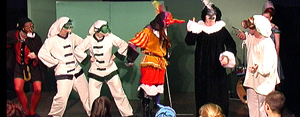Whether we believe in Commedia dell’Arte as in totally improvised genre or not, there is always an element of improvisation in it. As an actor one can only be in control of two other elements at the same time. One of these elements is always the audience since they are an active part in Commedia dell’Arte. That leaves us with only one mask to interact with simultaneous. Therefore we need strategies to deal with situations when there are more masks on stage.
The stage is also usually very small; wish is also a reason for dividing the stage, as we talked about in the STAGE.
Here we can take help from Tim Fitzpatrick who has studied strategies to solve situations like this. He has divided the plot in segments and has made a system of different techniques to create binary relations. Most of the time we use this strategies or conventions without thinking about it, but it still very good to have in the back of our heads when we start improvising.
- The first group of strategies he calls paired masks:
Unison masks is about two or more masks that acts together as one unit, but still as individual masks. The masks in the unit can either be active or passive listeners, but they always act together. - Subordinated masks are when a third mask becomes something of a listener on stage. This is used when a mask is indispensable for a scene, either for plot or comical reasons, but don’t have anything specific to do. The classic example is when Arlecchino is eating cherries and spitting out the stones while the lovers have a love scene. He is necessary both for comical reasons, the contrast between the actions, and for the plot, he might need to see the love scene.
- Fixed staging might be the most simple, but also the most (at least for the actors) boring solution. By fixing the movements on stage the actors always knows where the focus is, but they have no space for improvisation. This is mostly applied in mass scenes, the opening and the finale.
- Fixed activities are rather how a lazzo works. Here we are talking about rehearsed gag or segments in a play. It can start anytime an actor give the cue, the other actors prepared for it and know focuses places on the stage.
Go to PART 2

Pingback: Gelosi (the Zealous Ones) 1568 – 1604 - Commedia dell'Arte & Vulgar ComedyCommedia dell'Arte & Vulgar Comedy
Pingback: The Stage |
Pingback: Stage strategies (Part 2) |